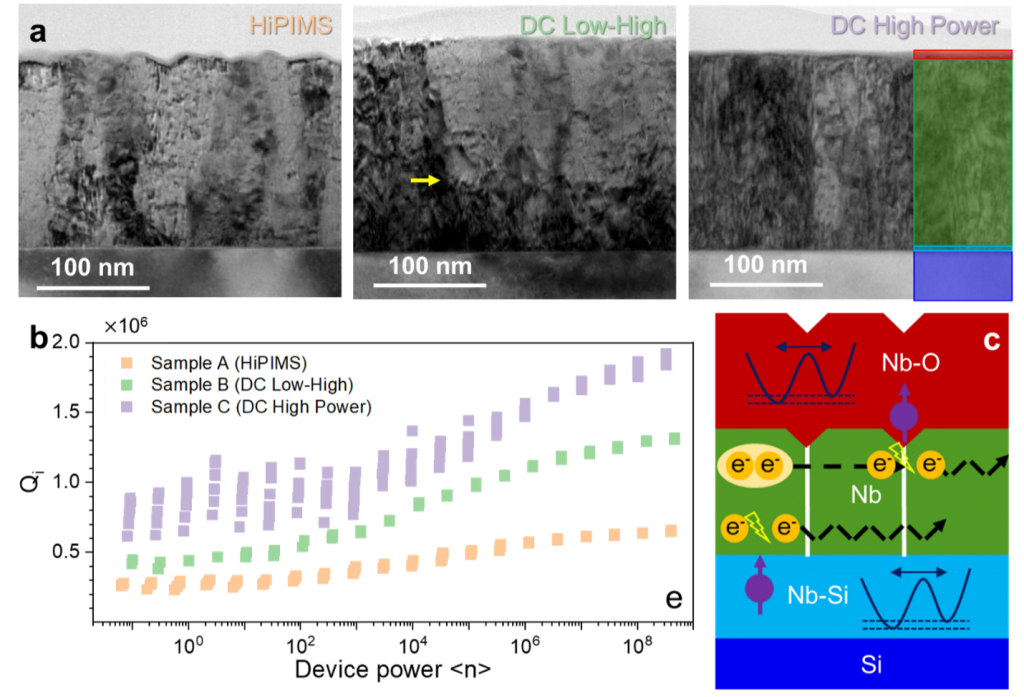Correlating Structural Imperfections to Resonator Performance
SQMS scientists explore how fabrication methods affect the microstructure and performance of superconducting coplanar waveguide resonators
The Science:
Superconducting qubits often use niobium (Nb) thin films due to their high critical temperature and excellent surface quality. Extensive efforts have been dedicated to characterizing qubits based on Nb thin films to identify materials-related relaxation channels for future fabrication optimization. This study examined Nb thin films deposited on silicon (Si) substrates using two methods: high-power impulse magnetron sputtering (HiPIMS) and direct current (DC) magnetron sputtering. Electron microscopy combined with advanced spectroscopy show that the HiPIMS-deposited films had smaller grains, thicker surface oxides, and thicker amorphous Nb/Si interface layers compared to DC-sputtered films. These microstructural differences correspond to variations in the films’ superconducting properties and the performance of superconducting coplanar waveguide resonators.

The Impact:
Our systematic investigation provides valuable insights into the relationship between thin film fabrication methods, various structural defects, loss mechanisms, and performance of superconducting qubits, which can guide the optimization of superconductor thin film deposition for qubit performance enhancement.
Summary:
We investigate the impact of deposition methods on the microstructure and performance of niobium thin films. A combination of characterization techniques, including advanced electron microscopy and spectroscopy, secondary ion mass spectrometry, magneto-optical imaging, and pump-probe spectroscopy, are employed to correlate the microstructure and properties from a multiscale perspective. Through correlating microstructures of Nb film to their residual resistance ratio (RRR), superconducting order parameters, quasiparticle density, and resonator internal quality factor (Qi), we elucidate how different types of structural defects, including interfaces and grain boundaries, impact the decoherence of superconducting quantum circuits in terms of TLS and non-TLS losses. Our systematic investigation clarifies material-based loss mechanisms.
Contact:
Lin Zhou – linzhou@ameslab.gov
Focus Area:
Materials for 2D and 3D Quantum Devices
Institutions:
Ames National Laboratory, Rigetti Computing, Fermi National Accelerator Laboratory, Illinois Institute of Technology
Citation:
Jin-Su Oh, Cameron J. Kopas, Jayss Marshall, Xiaotian Fang, Kamal R. Joshi, Amlan Datta, Sunil Ghimire, Joong-Mok Park, Richard Kim, Daniel Setiawan, Ella Lachman, Joshua Y. Mutus, Akshay A. Murthy, Anna Grassellino, Alex Romanenko, John Zasadzinski, Jigang Wang, Ruslan Prozorov, Kameshwar Yadavalli, Matt Kramer, Lin Zhou, Exploring the Relationship between Deposition Method, Microstructure, and Performance of Nb/Si-based Superconducting Coplanar Waveguide Resonators. Acta Materialia 120153 (2024). https://doi.org/10.1016/j.actamat.2024.120153
Funding Acknowledgment:
This work was supported by the U.S. Department of Energy, Office of Science, National Quantum Information Science Research Centers, Superconducting Quantum Materials and Systems Center (SQMS) under contract No. DE-AC02-07CH11359. All electron microscopy and related work were performed using instruments in the Sensitive Instrument Facility in Ames National Laboratory. The Ames National Laboratory is operated for the U.S. Department of Energy by Iowa State University under Contract No. DE-AC02-07CH11358. We thank the Rigetti fab team members for the processing development and fabrication of studied specimens.
